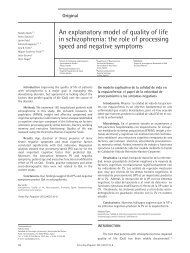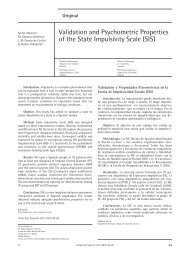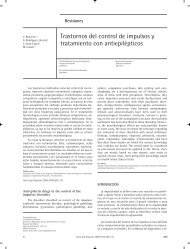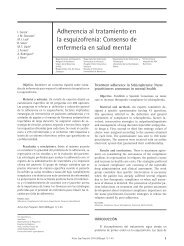Chronic hallucinatory psychosis. A case report - Actas Españolas de ...
Chronic hallucinatory psychosis. A case report - Actas Españolas de ...
Chronic hallucinatory psychosis. A case report - Actas Españolas de ...
Create successful ePaper yourself
Turn your PDF publications into a flip-book with our unique Google optimized e-Paper software.
I. Morán Sánchez 1<br />
A. <strong>de</strong> Concepción Salesa 2<br />
372<br />
Clinical notes<br />
<strong>Chronic</strong> <strong>hallucinatory</strong> <strong>psychosis</strong> is a clinical picture<br />
<strong>de</strong>scribed by Ballet in 1912. Together with paraphrenia and<br />
paranoia, it forms a part of the chronic <strong>de</strong>lusions that<br />
<strong>de</strong>scribes the French nosology separately from schizophrenia.<br />
It is characterized by the presence of mental automatism,<br />
chronic hallucinations and secondary <strong>de</strong>lusions. This is a<br />
fairly uncommon clinical picture in our setting and is often<br />
confused with other pictures. We <strong>report</strong> a <strong>case</strong> of a 52-yearold<br />
woman and we discuss various clinical and diagnostic<br />
issues related to the disturbance.<br />
Key words:<br />
<strong>Chronic</strong> <strong>hallucinatory</strong> <strong>psychosis</strong>, diagnosis, involuntary treatment<br />
<strong>Actas</strong> Esp Psiquiatr 2010;38(6):372-3<br />
Psicosis alucinatoria crónica. A propósito <strong>de</strong><br />
un caso<br />
La psicosis alucinatoria crónica es un cuadro clínico<br />
<strong>de</strong>scrito por Ballet en 1912. Junto con la parafrenia y<br />
paranoia forma parte <strong>de</strong> los <strong>de</strong>lirios crónicos que <strong>de</strong>scribe<br />
la nosología francesa <strong>de</strong> forma separada <strong>de</strong> la esquizofrenia.<br />
Constituye un cuadro clínico con automatismo<br />
mental, alucinaciones crónicas y <strong>de</strong>lirios secundarios a<br />
dichas alucinaciones. Es una entidad poco frecuente en<br />
nuestro medio y que a menudo se confun<strong>de</strong> con otros<br />
cuadros clínicos. Presentamos el caso clínico <strong>de</strong> una mujer<br />
<strong>de</strong> 52 años y consi<strong>de</strong>ramos varios aspectos clínicos y<br />
diagnósticos relacionados con la alteración<br />
Palabras clave:<br />
Psicosis alucinatoria crónica; diagnóstico diferencial, tratamiento involuntario<br />
Correspon<strong>de</strong>nce:<br />
Inés Morán Sánchez<br />
CSM Cartagena.<br />
Calle Real nº 8.<br />
CP 30201. Cartagena (Murcia)<br />
E-mail: Inmosa77@hotmail.com<br />
<strong>Chronic</strong> <strong>hallucinatory</strong> <strong>psychosis</strong>.<br />
A <strong>case</strong> <strong>report</strong><br />
1 Centro <strong>de</strong> Salud Mental<br />
Cartagena (Murcia)<br />
2 Hospital Psiquiátrico Román<br />
Alberca (Murcia)<br />
INTRODUCTION<br />
<strong>Actas</strong> Esp Psiquiatr 2010;38(6):372-3<br />
<strong>Chronic</strong> <strong>hallucinatory</strong> <strong>psychosis</strong> is a clinical picture first<br />
<strong>de</strong>scribed by G. Ballet. 1 It is characterized by the presence of<br />
mental automatism, together with hallucinations and<br />
<strong>de</strong>lusions. 2 Although the patients do not have schizophreniatype<br />
<strong>de</strong>fect, the prognosis is not totally favorable since the<br />
symptoms do not completely disappear with psychodrugs. 3<br />
In recent years, cognitive-behavior type therapies are being<br />
tested to improve the diagnosis. 4<br />
CLINICAL CASE<br />
We present the <strong>case</strong> of a 52-year old woman who was<br />
referred from primary care for evaluation of probable<br />
psychotic symptoms.<br />
She had no somatic background of interest. The EEG<br />
and cranial CT scan were normal. As psychiatric background,<br />
she had a hospital admission with diagnosis on discharge of<br />
disor<strong>de</strong>r due to <strong>de</strong>lusional i<strong>de</strong>as. She did not follow<br />
treatment and did not go to psychiatric checkups after on<br />
her own initiative. She returned to the Mental Care Center<br />
for evaluation when she requested discharge in or<strong>de</strong>r to<br />
return to work.<br />
The clinical picture began approximately two years<br />
before she came to our medical office. At work, she began<br />
to hear voices that reproached her. She interpreted these<br />
voices as revenge from a colleague who was in love with her.<br />
As he was not reciprocated, he began to insult her in or<strong>de</strong>r<br />
to make her leave her workplace. She believed that the<br />
voices could reach her through her computer or by telephone<br />
so that she disconnected both of them. At home, she began<br />
to hear the voices and interpreted them as part of a complot.<br />
She had null awareness of disease and need for treatment,<br />
so that after her first contact with Mental Health, she<br />
<strong>de</strong>ci<strong>de</strong>d not to return for the check-ups. Therefore, she was<br />
referred to the hospital for admission. After hospital<br />
discharge, she continued without follow-up and when she<br />
60
I. Morán Sánchez, et al<br />
61<br />
<strong>Chronic</strong> <strong>hallucinatory</strong> <strong>psychosis</strong>. A <strong>case</strong> <strong>report</strong><br />
came to our medical office, the symptoms had not varied,<br />
although the i<strong>de</strong>a of a complot to keep her away from work<br />
had become stronger. We also found thought diffusion and<br />
telepathy phenomena, which the patient interpreted as<br />
secondary to the medication prescribed, “that she has been<br />
channeled towards a parallel world.” She was well-dressed,<br />
with good appearance. Her speech was long-win<strong>de</strong>d with<br />
pronounced stress when referring to the work subject.<br />
Suspicious with null disease awareness. No hostile or<br />
disruptive behaviors appeared secondary to the <strong>de</strong>lusional<strong>hallucinatory</strong><br />
picture, although the usual ten<strong>de</strong>ncy to<br />
isolation of the patient was even greater (this was confirmed<br />
in interviews ma<strong>de</strong> with family members). No biological<br />
rhythm disor<strong>de</strong>rs were observed.<br />
DISCUSSION<br />
The interest of this clinical <strong>case</strong> is because of the<br />
diagnostic and therapeutic difficulties. We propose the<br />
possible diagnoses of schizophrenia, temporal lobe epilepsy,<br />
<strong>de</strong>lusional i<strong>de</strong>as disor<strong>de</strong>r and chronic <strong>hallucinatory</strong> <strong>psychosis</strong>.<br />
The absence of formal thought and process <strong>de</strong>terioration<br />
disor<strong>de</strong>rs had led us to rule out schizophrenia. 5 The normal<br />
EEG and absence of other characteristics of seizures go<br />
against the diagnosis of temporal epilepsy. The fact that the<br />
<strong>hallucinatory</strong> picture was primary with a subsequent<br />
<strong>de</strong>lusional <strong>de</strong>velopment and the persistence of hallucinations<br />
during the entire process had led us to rule out <strong>de</strong>lusional<br />
i<strong>de</strong>a disor<strong>de</strong>r and to issue the final clinical opinion of <strong>Chronic</strong><br />
Hallucinatory Psychosis.<br />
The therapeutic approach is difficult because of the<br />
total lack of disease awareness, pronounced suspicion of<br />
the patient and previous unsatisfactory experiences. We<br />
tried to establish a therapeutic alliance during frequent<br />
interviews, stressing the need for treatment of objective<br />
features such as anxiety and the effective repercussion on<br />
everything she told us. 6 In the interviews, we avoi<strong>de</strong>d direct<br />
confrontation of the <strong>de</strong>lusions and excessive kindness to<br />
avoid increasing her suspiciousness. We began antipsychotic<br />
treatment with slow dose increases to minimize si<strong>de</strong><br />
effects and we ma<strong>de</strong> an agreement with her to evaluate<br />
response and successive visits. After obtaining the patient’s<br />
permission, we contacted her family members and the<br />
medical practitioner. We assured with the family that<br />
there were no severe alterations at home. We established<br />
common action regimes with the medical practitioner. If<br />
<strong>Actas</strong> Esp Psiquiatr 2010;38(6):372-3<br />
minimum behavioral alteration or self- or hetero-aggressive<br />
i<strong>de</strong>as appear, we will proceed to hospitalization.<br />
After several failed drug attempts (incongruent si<strong>de</strong><br />
effects with the doses prescribed were <strong>report</strong>ed) we proposed<br />
<strong>de</strong>pot antipsychotic medication, the patient totally rejecting<br />
this possibility. Her motivation for treatment, as she openly<br />
expressed, was to obtain a psychiatric <strong>report</strong> allowing her to<br />
return to work. After achieving it, she stopped coming to<br />
the check-ups. We proposed including her in the assertive<br />
community treatment program, with unsuccessful results.<br />
At this point, in which the conventional therapeutic<br />
relationship has en<strong>de</strong>d, we are proposing the possibility of<br />
forced outpatient treatment. 7 Although there is no specific<br />
legislation in this field that makes it possible to have a<br />
standardized application, in our country, there are isolated<br />
experiences with good preliminary results. Its application is<br />
not exempt of controversy, its <strong>de</strong>tractors consi<strong>de</strong>ring it a<br />
repressive measure that increases stigmatization. However,<br />
in patients diagnosed with <strong>psychosis</strong> and together with the<br />
intensive follow-up programs in the community, the riskbenefit<br />
balance would be positive. We consi<strong>de</strong>r that our<br />
patient would benefit from this type of treatment.<br />
REFERENCES<br />
1.<br />
2.<br />
3.<br />
4.<br />
5.<br />
6.<br />
7.<br />
Las psicosis <strong>de</strong>lirantes crónicas. In: Ey H, Bernard P, Brisset CH,<br />
editors. Tratado <strong>de</strong> Psiquiatría. Octava ed. Barcelona: Masson;<br />
1978. p. 458-61.<br />
Psicosis alucinatoria crónica. Presentación <strong>de</strong> un caso<br />
clínico. Ballester Graciá M, Martinez Pérez A, Brotons<br />
Sánchez L, editors. I Congreso Virtual <strong>de</strong> Psiquiatría 1<br />
Febrero-15 Marzo 2000.Comunicación 4-CO-C. 8-2-2000.<br />
Ref Type: Internet Communication<br />
Chabrol H. <strong>Chronic</strong> <strong>hallucinatory</strong> <strong>psychosis</strong>, boufée délirante,<br />
and the classifi cation of <strong>psychosis</strong> in French psychiatry. Curr<br />
Psychiatry Rep 2003;5(3):187-91.<br />
Gutiérrez López MI, Sánchez Muñoz M, Trujillo Borrego A,<br />
Sánchez Bonome L. Terapia cognitivo-conductual en las psicosis<br />
crónicas. <strong>Actas</strong> Esp Psiquiatr 2009;37(2):106-14.<br />
Dolfus S, Petit M, Menard JF. The relationship between “<br />
chronic <strong>hallucinatory</strong> <strong>psychosis</strong> (CHP) and schizophrenia. Eur<br />
Psychiatry 1992;7:271-6.<br />
<strong>de</strong> Concepción Salesa A, Corbalán Vélez R, Morán Sánchez I,<br />
Bruffau C. Abordaje <strong>de</strong>l <strong>de</strong>lirio parasitario en la consulta <strong>de</strong><br />
Dermatología. Actualidad <strong>de</strong>rmatológica 2006;45:335-41.<br />
Hernán<strong>de</strong>z Via<strong>de</strong>l M, Pérez Prieto JF, Cañete Nicolás C, Lera<br />
Calatayud G. Tratamiento ambulatorio involuntario para<br />
personas con enfermedad mental grave. Psiquiatría Biológica<br />
2006;13:183-8.<br />
373
















